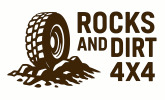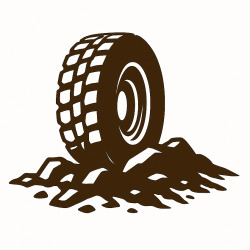When you think about the perfect adventure rig, most folks picture something practical - maybe some modest tires, a roof rack, and enough gear to survive a weekend at the local campground. Then there’s Sean from The Story Till Now, who decided to stuff a 426 Hemi under the hood of his ‘22 Jeep Gladiator and mount it on 40" rubber. This isn’t your typical overlander - this is what happens when someone builds a truck specifically to reach places where most people won’t sacrifice their paint job.

Sean’s approach to adventure travel cuts through all the Instagram-friendly gear talk that dominates so much of the off-road space these days. His Gladiator represents something different - a tool built for genuine exploration rather than campground posing. The truck rolls on 40" Toyo MTs wrapped around 17" KMC beadlocks, sitting atop a 5.5" suspension lift with Ultimate Dana 60 axles front and rear. The factory Rubicon 4:1 transfer case remains, because when you’re already running this much capability, why mess with what works?
The Hemi swap came courtesy of America’s Most Wanted and was installed by Epic Adventure Outfitters up in British Columbia. Sean jokes about the microphone he’s mounted in the engine bay to capture those sweet V8 sounds, but the performance upgrade serves a real purpose beyond just noise. When you’re tackling terrain that would make most rigs turn around, having that extra power on tap means the difference between making it through a gnarly section or spending hours winching.
Speaking of winching, the front bumper houses serious recovery gear, while aluminum armor all around saves weight without sacrificing protection. The lighting setup is pure KC Hilites - Flex A4s up front in amber, rock lights underneath for technical night driving, Cyclones on the A-pillars, and Flex A3s for side illumination. Up top, a KC Titan light bar can throw either amber or white light depending on conditions.
What really sets this build apart is how Sean thinks about spare tire placement. Instead of hanging a 40" spare on a rear tire carrier like so many builds attempt, he straps it inside the bed as far forward as possible. He learned this lesson the hard way after bending his first Gladiator in half - the factory frame simply can’t handle that much weight hanging off the back, especially when you start hitting bump stops hard on technical terrain.
The camping setup stays deliberately simple with a Goose Gear kitchen slide and the new GFC V2 Pro platform camper. A Sherpa over-cab rack mounts his Starlink, which feeds directly into a Red Arc electrical system. This streamlined approach reflects Sean’s philosophy that the truck should enable adventure, not become the adventure itself.
Living in British Columbia gives Sean access to some seriously remote terrain, though he points out that even his wildest-looking trips are often just a couple hours from civilization. Still, the truck’s range becomes academic when you’re aired down in 4 low, crawling through technical sections. Highway driving nets about 400 kilometers (249 miles) per tank, but all bets are off once you leave the pavement - especially if you’re making those sweet Hemi noises for the camera.
Sean’s content focuses on genuine exploration rather than gear reviews or build breakdowns. He scouts routes using satellite imagery, looking for forgotten roads, abandoned mines, or interesting geological features that might make for a good adventure. The planning is minimal - if it looks like they can potentially get there, even if it requires some serious work, that’s enough reason to attempt it.
This approach has led to some memorable failures, like the time they put tracks on the 600HP Jeep and spent eight hours repairing them in the middle of nowhere. But that’s exactly the point - the truck gets used as a tool, complete with all the scratches and battle scars that come with real adventure use.
The build represents something that’s become increasingly rare in the overlanding space - a vehicle designed around capability rather than aesthetics. While others debate the merits of different fridge brands or argue about solar panel configurations, Sean’s out there proving that sometimes the best approach is to build something that can go anywhere and figure out the details as you go.
You can follow Sean’s adventures on his YouTube channel, where he documents the kind of trips that remind you why we build these rigs in the first place. It’s not about having the perfect setup or the most Instagram-worthy camp kitchen - it’s about having the capability to reach places that make the journey worthwhile, even if it means coming home with a few more scratches on the wrap.
Discover More
- How to Turn a Nearly-New $11,700 Wrecked Ranger Into a Sweet Budget Build
- This '03 Taco Looks Stock... Until You See It Skimming Whoops
- A Minimal, Removable, Stealth Camper in a Toyota Tundra Bed
- A Sleeper Taco on 35s/16" Travel/Supercharged That Does It All
- Budget Workshop Goals - Why Shipping Containers Are the New DIY Secret
- Build a 270 Degree Overland Awning for Under $150 - Here’s How
- From Salvage 4Runner to Race-Ready Beast - A DIY King of the Hammers Build
- From Stock to Savage: This Toy 4Runner Build Conquers Rocks, Desert...and Daily Life
- How a Stock Taco Became a 60 MPH Whoop-Slayer (Hint: Ls3)
- How a Wildland Firefighter Crafted the Ultimate Off-Grid Basecamp
- How Jack Turned a Daily Driver Taco Into a 37” Tire Beast - It Always Starts With Marketplace...
- Inside the Wild Build: Suzuki Samurai Goes Ultra4 Racing at KOH
- Is 7.5mpg Worth It to Run 37s on Your 4Runner and Become a Rockcrawling Beast?
- Notch a Tube in 2 Minutes, 38 Seconds - Without a Tube Notcher
- Supercharger, Long-Travel, 37s, and Overlanding - Is This the Tacoma You've Been Looking For?
- This Awesome DIY Taco Camper Build Proves You Don’t Need Big Bucks for Big Adventure
- This Clapped-Out Taco on 37s Is the Overland Rig You Wish You Had
- This Jeep Gladiator Packs a 426 Hemi for Real Off-Road Adventure in the Canadian Backcountry
- Unlock the Truth: Spring Over or Spring Under for Ultimate Off-Road Performance?
- What It’s Really Like to Race the Every Man Challenge at King of the Hammers See more

